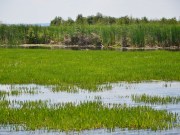By Mike Anderson
The province will provide $24 million over the next three years to help build a state-of-the-art phosphorus recycling facility in the Holland Marsh.
The funding announcement was made in Bradford on April 20 by David Piccini, Minster of the Environment, Conservation and Parks, and York-Simcoe MPP Caroline Mulroney.
The facility could reduce phosphorus discharge from the Holland River into Lake Simcoe by up to 40 per cent and remove between 2.5 to 12 tonnes of phosphorus from Lake Simcoe per year.
While the 2009 Lake Simcoe Protection Plan (LSPP) has a phosphorus load target of 44 tonnes, phosphorus levels continue to rise, primarily due to increased residential and commercial growth.
The LSRCA reported that phosphorus levels spiked at 113 tonnes in 2017-18, the most recent reporting period.
High phosphorus levels can lead to excessive weeds and toxic algae which deplete oxygen levels in the lake, threatening fish habitats and impacting water quality.
“Our government is saying “yes” to building this new innovative facility because we recognize that keeping our local waterways safe and clean will help protect Lake Simcoe, its watershed, and the communities that call it home,” said Piccini in a media release.
“By investing in a new phosphorus recycling facility in the Holland Marsh, our government is taking the necessary action to ensure that Lake Simcoe remains healthy and can be enjoyed by residents and visitors for generations to come,” added Mulroney.
The new provincial funding represents 60 per cent of the project’s total cost of $40 million, the other $16 million is being provided through a federal infrastructure fund.
When the federal funding was announced in 2020, the project was billed as a joint partnership between York Region and the federal government, with the Region agreeing to provide the $24 million.
But the Region appeared to back away from that commitment last year after the province declined to greenlight the Upper York Sewage Solution (UYSS), a new sewage treatment plant that would service future growth in Aurora, Newmarket and East Gwillimbury.
The Region argued that funding for the phosphorus recycling facility was contingent on the province’s approval of UYSS.
But that didn’t sit well with two local councillors, Bradford’s Jonathan Scott and Georgina’s Dave Neeson. Last fall, they began lobbying behind the scenes to drum up support for the phosphorus recycling facility.
They met with officials in Ottawa, at Queen’s Park and staff at York Region, as well as local mayors, councillors, MPs and MPPs.
They also encouraged local municipal councils to pass motions which called on the federal and provincial governments to work collaboratively to move the recycling facility forward.
“There was at least one councillor in every watershed municipality who stepped up to the plate to introduce a version of the motion that Dave and I kicked off last fall,” Scott told the Post.
“This project is an important piece of environmental mitigation infrastructure that provides the single largest reduction of phosphorous runoff into our lake that’s ever been proposed,” he said.
“And with the province stepping up to fund the remaining 60 per cent of the capital costs, I’m hoping it’s full steam ahead to deliver this project.”
“This announcement is an absolute game-changer for the health of Lake Simcoe and its entire watershed,” Neeson added.
“We put a lot of work into it. And usually, things don’t happen that quickly, nor do you get that level of collaboration.”
“It’s the first time we’ve been able to walk something like this around the watershed, and we got every single watershed municipality to pass it.”
Both Scott and Neeson believe a precedent has been set — that infrastructure, like the phosphorus recycling plant, should be tied to future growth.
“In a growing region like ours, when we talk about the infrastructure we need, it should include compensatory environmental infrastructure, as well as bridges, transit and servicing for condos and the like,” Scott said.
“So we’re setting a good precedent that we want to have sustainable development, including the environmental mitigation pieces of the puzzle.”

While Minister Piccini said he expects the plant to be built within three years, there are still significant hurdles to overcome, including a possible jurisdictional issue.
The facility is anticipated to be built on the Holland River between Bradford and King, but the exact location is yet to be determined.
According to York Region Chair and CEO Wayne Emmerson, the plant’s location could decide which jurisdiction builds and operates it, as the Holland Marsh cuts through both Simcoe County and King Township.
“It’s fantastic news that the province is anteing up $24 million. But they haven’t told us who is actually going to be building it and who’s going to run it,” Emmerson said.
“I believe it’s going to be put in King Township in York Region. But maybe the province will build it, or say Simcoe County run it and build it. We’re willing to do it, but the province has to tell us.”
“Now we have the funding; the next step is the EA and who will build it.”
- The Canadian Moose are off to Vietnam - October 11, 2025
- Province set to ban speed cameras, as Town defends their use - October 9, 2025
- Celebrating the harvest: A look back at farming in Georgina - October 8, 2025










































